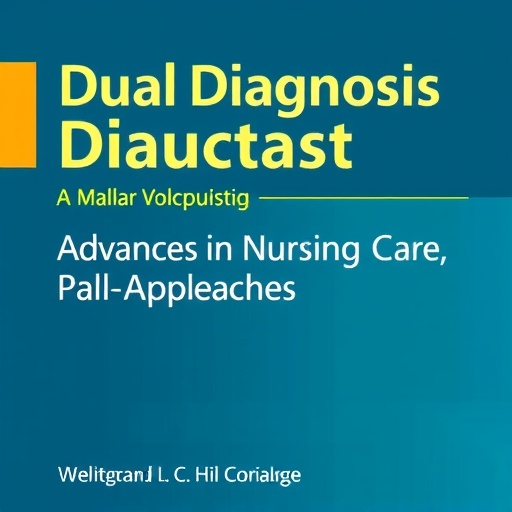In a pioneering study that promises to reshape nursing care practices, a comprehensive literature review has recently been conducted by researchers Nsatimba, Sehularo, and Moagi, focusing on the intricate challenges associated with dual diagnosis in patients. The findings, published in the esteemed BMC Nursing journal, delve into the complexities faced by healthcare providers when addressing the needs of individuals diagnosed with both mental health disorders and substance use issues. This intersection of mental and physical health poses unique difficulties for nursing professionals, demanding not only a nuanced understanding of the conditions but also innovative approaches to care.
The ongoing surge in dual diagnosis cases underscores an urgent need for healthcare systems to adapt and enhance their approach to nursing care. As highlighted in the literature, dual diagnosis patients often navigate a treacherous landscape of stigma, resulting in significant barriers to accessing appropriate treatment. Without tailored nursing interventions, these patients may experience exacerbated symptoms of both conditions, leading to a vicious cycle of health deterioration. The research emphasizes the critical role nurses play not only as caregivers but also as advocates for these patients, who frequently encounter obstacles in the traditional healthcare setting.
Through meticulous analysis, Nsatimba and colleagues uncovered a wealth of strategies that have been implemented to improve care for dual diagnosis patients. The review showcases various nursing models and frameworks that have shown promise in enhancing patient outcomes. For instance, integrated care models that encourage collaboration between mental health and addiction services are highlighted as effective. Such collaborative approaches facilitate a holistic treatment plan tailored to the unique needs of the individual, addressing both psychological and physiological aspects of dual diagnosis.
Moreover, the role of ongoing professional development cannot be overstated in this context. The literature emphasizes that continuous education and training for nursing staff are paramount in equipping them with the most current knowledge and skills necessary to manage complex cases. By fostering an environment of lifelong learning, healthcare institutions can ensure that their nursing teams remain adept at tackling the evolving landscape of dual diagnosis care, thereby improving quality of care and patient satisfaction.
A particularly troubling aspect identified in the review is the prevalence of underdiagnosis among dual diagnosis patients. Many individuals remain undiagnosed due to the stigma associated with mental illness and addiction. This not only hampers effective treatment but also perpetuates a cycle of neglect and misunderstanding in nursing care. The researchers call for heightened awareness and improved diagnostic practices among nursing professionals, ensuring that no patient falls through the cracks in this multifaceted care landscape.
The literature review also delves into the importance of culturally competent care, emphasizing that understanding cultural backgrounds is vital when addressing dual diagnosis cases. Nurses must be equipped to recognize how cultural factors influence health behaviors and attitudes towards treatment. By tailoring their approaches to resonate with the cultural contexts of their patients, nurses can foster trust and encourage greater engagement in treatment, ultimately leading to improved health outcomes.
As the review progresses, it highlights the indispensable role of technology in enhancing nursing practices around dual diagnosis. Telehealth resources, mental health apps, and electronic health records can significantly improve communication and continuity of care. For example, technology can facilitate regular check-ins, thus allowing nurses to monitor patients’ progress and adapt their care strategies in real-time. This flexibility is crucial for managing the complexities inherent in dual diagnosis, providing a proactive rather than reactive approach.
The findings from Nsatimba and his colleagues are not just a call to action within the nursing community; they also extend to policymakers and healthcare administrators. Effective change requires a systemic approach that prioritizes dual diagnosis care within healthcare frameworks. This includes better funding for training programs, resources for integrated care services, and policies that support the holistic needs of patients with dual diagnoses.
Moreover, the authors assert that patient involvement in their care plans is vital for successful outcomes. Empowering patients to take an active role in their treatment fosters a sense of ownership and accountability, leading to more sustainable recovery paths. Nurses are encouraged to incorporate shared-decision making frameworks into their practice, allowing patients to voice their preferences and actively engage in their health choices.
The review concludes with a forward-looking perspective, anticipating future directions in dual diagnosis nursing care. It emphasizes the need for research innovations that investigate new therapeutic techniques, nursing interventions, and care models that address the specific needs of this patient population. As the landscape of mental health and addiction continues to evolve, so too must the strategies employed by nursing professionals to ensure that they remain effective in this critical area of healthcare.
The comprehensive literature review by Nsatimba, Sehularo, and Moagi sets a robust foundation for advancing nursing care practices for patients with dual diagnoses. By recognizing the multifaceted challenges these patients face and implementing holistic, integrated approaches, the nursing community can significantly improve patient outcomes. This study urges continuous education, policy reform, and patient-centered care as key tenets in transforming dual diagnosis nursing practices.
In summary, the ongoing evolution of dual diagnosis care within nursing offers a vital opportunity for impact in patient health outcomes. As the field continues to grow, nurses must remain vigilant, informed, and responsive to the needs of their patients, ensuring that their care strategies evolve in tandem with the complexities of dual diagnosis.
Subject of Research: Nursing care of patients diagnosed with dual diagnosis and the challenges inherent in this area.
Article Title: The current nursing care of patients diagnosed with dual diagnosis: a comprehensive literature review.
Article References:
Nsatimba, F., Sehularo, L. & Moagi, M. The current nursing care of patients diagnosed with dual diagnosis: a comprehensive literature review.
BMC Nurs 24, 1380 (2025). https://doi.org/10.1186/s12912-025-04027-3
Image Credits: AI Generated
DOI: https://doi.org/10.1186/s12912-025-04027-3
Keywords: Dual diagnosis, nursing care, mental health, substance use, integrated care, professional development, cultural competence, technology in nursing, patient empowerment, shared decision making.




